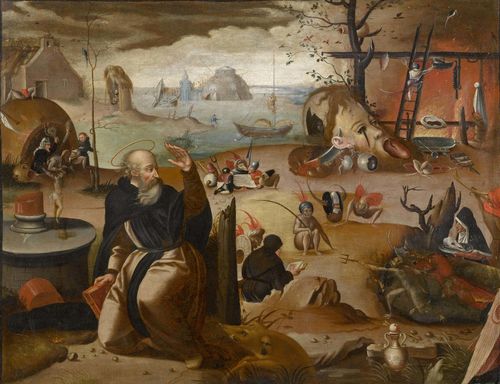
拍品 3019 - A162 大师画作 - Freitag, 21. September 2012, 03.00 PM
ANTWERP, CIRCA 1550
The Temptation of Saint Anthony. Tempera on canvas. 69 x 89.8 cm. Provenance: Swiss private collection. The composition as well as the stylistic execution of this lot with the Temptation of Holy Anthony is related to the painting previously located in the Paul Dansette Collection (Oil on wood, 45,5 x 55,5 cm), which Gerd Unverfehrt brings in connection with the Mandyn-Huys group of unsigned and not fully identified works with influences from both artists (see: Unverfehrt, Gerd: Hieronymus Bosch. Die Rezeption seiner Kunst im frühen 16. JAHRHUNDERT, Berlin 1980, Kat. Nr. 132, pp. 282-283, fig. 148). The latter was described by Marlier as a work by Jan Mandyn (Marlier, G.: Jan Mandyn, in: Le Siècle de Bruegel, Ausst. Kat. Musées Royaux des Beaux-Arts, Brüssel 1963, Nr. 152), with the figures more relating to the style of Pieter Coecke. Jan Mandyn and Pieter Huys (about 1519/20-1581/84) were followers of Hieronymus Bosch and had continued his tradition of the fantastic painting in Antwerp in the middle of the 16th century. As a possible attribution Dr. Larry Silver considers Gillis Mostaert (1528-1598) as the author of this painting and we thank him for his opinion. This work has been painted in the "Tuchlein" technique, which means that the tempera- pigments where bound with animal glue, and which was most popular with early Netherlandish painters around Quentin Massys.
Die Versuchung des Heiligen Antonius.
Tempera auf Leinwand.
69 x 89,8 cm.
Provenienz: Schweizer Privatsammlung. Diese Versuchung des Heiligen Antonius ist stilistisch wie kompositorisch eng verwandt mit dem Gemälde ehemals in der Sammlung Paul Dansette (Öl auf Holz, 45,5 x 55,5 cm), welches bei Gerd Unverfehrt unter der Gruppe Mandyn-Huys aufgeführt ist, in der er unsignierte und nicht eindeutig zu identifzierende Werke mit Einflüssen beider Meister zusammenführt (siehe Unverfehrt, Gerd: Hieronymus Bosch. Die Rezeption seiner Kunst im frühen 16. Jahrhundert, Berlin 1980, Kat. Nr. 132, S. 282-283, Abb. 148). Letzteres war 1963 von Marlier (Marlier, G.: Jan Mandyn, in: Le Siècle de Bruegel, Ausst. Kat. Musées Royaux des Beaux-Arts, Brüssel 1963, Nr. 152) als ein Werk Jan Mandyns (Haarlem um 1500 - um 1559 Antwerpen) bezeichnet, wobei die Figuren dem Stil von Pieter Coecke verwandt sind. Jan Mandyn wie Pieter Huys (um 1519/20-1581/84) stehen in der Nachfolge Hieronymus Boschs und setzen dessen Tradition der fantastischen Malerei in Antwerpen in der Mitte des 16. Jahrhunderts fort. Als eine mögliche Zuschreibung nimmt Dr. Larry Silver Gillis Mostaert (1528-1598) als Künstler dieser Arbeit in Betracht, wofür wir ihm danken. Das Gemälde ist in der "Tüchlein" Technik gemalt, bei der die Tempera-Pigmente mit einem tierischen Leim gebunden wurden, und die vorwiegend bei den frühen niederländischen Malern um Quentin Massys in Gebrauch war.
CHF 18 000 / 25 000 | (€ 18 560 / 25 770)
以瑞士法郎銷售 CHF 36 000 (包含買家佣金)
所有信息随时可能更改。
